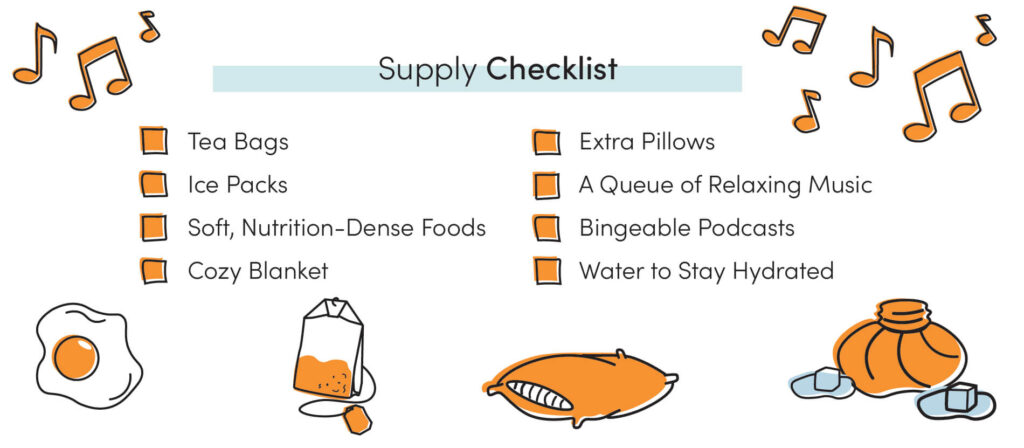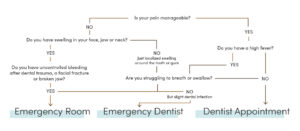How to Stop Bleeding After Tooth Extraction: Easy Tips for Immediate Relief

Reviewed By Dr. Dennis Rollins, DDO |
July 2025 • 6 min Read
Reviewed By Dr. Dennis Rollins, DDO | July 2025 • 6 min Read
After a tooth extraction, some bleeding at the site is normal and will usually slow down within 2-3 hours. Gentle oozing (think pink saliva) will often continue for the first 24 hours.
Below you’ll find tips for helping to stop the bleeding, and how to tell the difference between normal recovery and signs that you should call your dentist.
What to Do After a Tooth Extraction
1. Apply Pressure with Gauze
Fold a piece of sterile gauze into a small pad, place it directly over the extraction site, and bite down on the gauze gently but firmly.
That slight pressure will squeeze blood vessels and tissue together, helping a blood clot to form and stabilize. (More on why that blood clot is so important below.) Keep the gauze in place for 30-60 minutes, only swapping it for a new one if it becomes saturated.

2. Use a Damp Tea Bag
If gauze hasn’t slowed the bleeding after an hour, moisten a regular black tea bag with cool water, squeeze out any excess liquid, place the tea bag on the site, and bite down gently.
Black tea contains tannins, natural plant compounds that act as an astringent, shrinking blood vessels and encouraging clotting. They can also have a mild soothing and anti-inflammatory effect.
Keep the tea bag in place for 30 minutes and check if the bleeding has slowed to a light oozing. If it has not, you can put in a new tea bag for another 30 minutes.
3. Apply a Cold Compress
Place an ice pack or a bag of frozen peas wrapped in a cloth on the cheek near the extraction site. Keep it on for 15 minutes, take it off for 15 minutes, and repeat.
The cold will constrict blood vessels, slowing bleeding and reducing swelling. It will also numb the area slightly, easing discomfort.
You can do this while using gauze or a tea bag, or after those steps are done.
4. Keep Your Head Elevated
Lying flat increases blood pressure in your mouth, which can make bleeding worse. For at least the first 24 hours after your extraction, sit upright in a chair or, if lying down, use extra pillows to keep your head above heart level. This will reduce blood flow to the extraction site.
5. Rest and Stay Hydrated
Staying hydrated helps with healing. Sip cool water, but avoid hot drinks, alcohol, and carbonated beverages, which can dissolve or loosen the blood clot.
It’s also important to rest for the day. After 24 hours, if the bleeding has stopped and the pain is manageable, you can ease your way back into physical activity. But wait to work out or mow the lawn until at least day four.
Why Staying Calm Matters (and How to Do It)
A tooth extraction can be distressing, but staying calm can lower your blood pressure, which helps reduce bleeding. Here are a few calming methods to try.
1. Deep, Slow Breathing
Inhale through your nose for four counts, hold for two, and then exhale slowly through your mouth for six. Repeating this for a few minutes encourages your nervous system to relax.
2. Soft, Relaxing Music or Podcasts
Listening to something soothing and distracting can help reduce stress hormones.
3. Controlling Your Environment
Dimming the lights, wrapping up in a cozy blanket, and minimizing noise and interruptions can help you feel safe and calm.
4. Positive Visualization
Imagine the blood clot forming and the gum tissue healing. Keep in mind that some bleeding is normal and that the vast majority of tooth extractions heal in time without problems.
All these methods can be combined for even better results. If possible, create a relaxation plan before your extraction, so you’re prepared to support your healing by staying calm.

Why Protecting the Blood Clot Is So Important
After a tooth extraction, the blood clot serves several crucial functions.
First and foremost, it stops the bleeding, sealing the blood vessels in the area. It covers the exposed socket, so that air, food, and fluids don’t irritate the sensitive tissue underneath.
Over days and weeks, it also forms the foundation for healing, gradually being replaced by gum tissue first, and then eventually bone.
It’s important to protect the blood clot because if it is disturbed or dislodged, bleeding can start again, and the healing process slows down. There is also an increased risk of a painful dry socket.
With all that in mind, let’s discuss ways to protect this vital part of healing.
What NOT to Do After a Tooth Extraction
1. Don’t Change the Gauze Too Often
Replacing the gauze interrupts clot formation, so make a change only when it’s soaked through. (The same goes for tea bags.)
2. Don’t Spit or Rinse Forcefully
Strong rinsing or spitting creates suction that can pull the clot out of the socket before it stabilizes.
3. Don’t Use Straws
The sucking motion creates negative pressure in your mouth, which can easily dislodge the clot.
4. Don’t Smoke or Vape
The suction action involved in smoking is similar to using a straw. What’s more, the chemicals in smoke delay healing and increase the risk of infection and a dry socket.
5. Don’t Drink Alcohol or Hot Beverages
Alcohol can irritate the wound and thins the blood, making it harder for the clot to form and stabilize. Hot liquids can dissolve or loosen the clot.
6. Don’t Touch the Extraction Site
Touching the area with your tongue, fingers, or objects can disturb the clot. It can also introduce bacteria, which raises the risk of infection.
7. Don’t Eat Crunchy, Hard, or Sticky Foods
Chips, nuts, seeds, popcorn, and sticky candies can get stuck in the socket or knock the clot loose. Stick to soft, cool, nutrient-dense foods instead.
Avoiding all these activities will help ensure your blood clot can do its job.
When to Call Your Dentist
Let’s compare signs of normal healing with symptoms that indicate you should reach out to your dentist.
Normal Healing Signs
- Bleeding that slows down 2-3 hours after the extraction.
- Mild bleeding (slow oozing) that stops within 24 hours.
- Swelling that peaks on day two or three and then starts going down.
- Pain that decreases day by day.
- White or yellowish tissue gradually covers the site.
Warning Signs
If at any point you experience severe swelling or difficulty breathing or swallowing, contact a dentist immediately.
For help finding a dentist in your area, click here or call us at (888) 597-3896.
Throughout healing, you should also reach out if you have fever or chills, or if you notice pus at the extraction site.
Here are other signs to watch out for.
On Days 1–2 (First 48 hours):
- Bleeding that doesn’t slow after 2–3 hours, despite use of gauze and tea bags.
- Gauze becoming saturated with blood every few minutes.
On Days 3–4:
- Pain that increases instead of gradually easing.
- Throbbing pain that radiates to the ear, temple, or jaw.
- A bad taste or odor coming from the extraction site.
On Days 5–7:
- Socket that looks empty or has bone exposed.
- Lack of gum tissue starting to close over the area.
- Swelling that returns after going down.
If none of these signs appear but you still have questions or concerns, don’t hesitate to call your dentist. Helping you through the healing process is part of their expertise.
Need Help Finding a Dentist?
Related Information

How Much Is a Dentist Visit Without Insurance? Exact Costs Explained
Below, you’ll find a breakdown of typical out-of-pocket costs for common dental procedures, along with the reasons behind these costs. Keep in mind that these costs can vary significantly based on your location, the dentist’s experience, the materials used, and the complexity of the procedure.

Should You Go to the ER for Tooth Pain? A Quick Guide
Whether you should go to the ER for tooth pain depends on the severity of your pain and what other symptoms you’re experiencing. Read on for help deciding how to find relief.

Dental Anxiety: Proven Strategies to Stay Calm During Your Appointment
If you’re feeling anxious about an upcoming dental visit, we can tell you this is completely normal. In fact, dental anxiety is something our dentists help people navigate all the time. Read on for practical tips, and to hear from other patients who experience dental anxiety.
